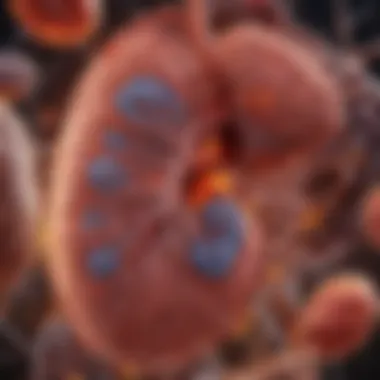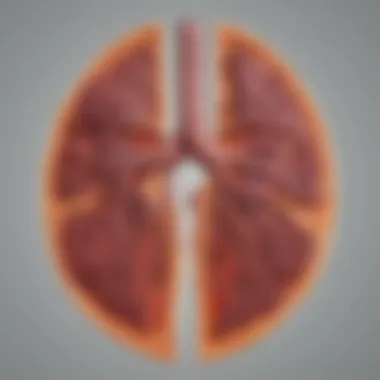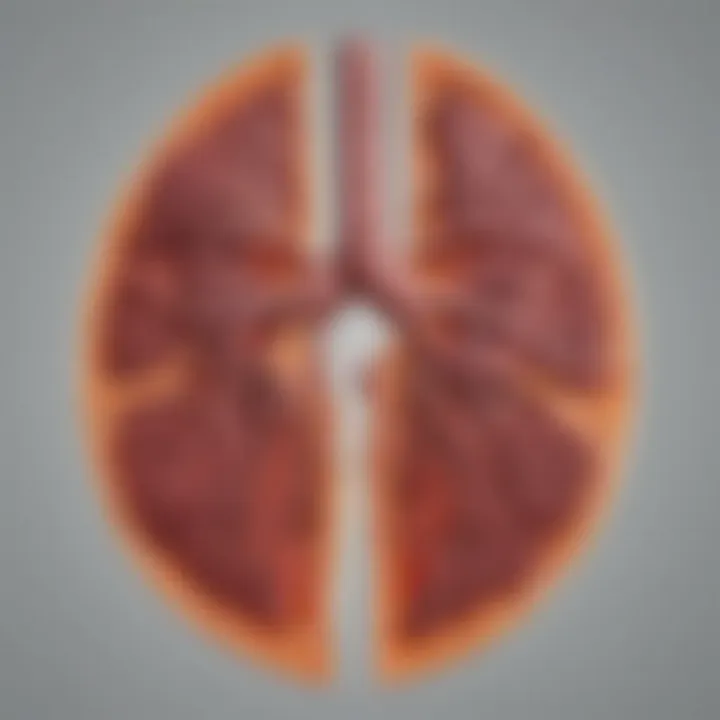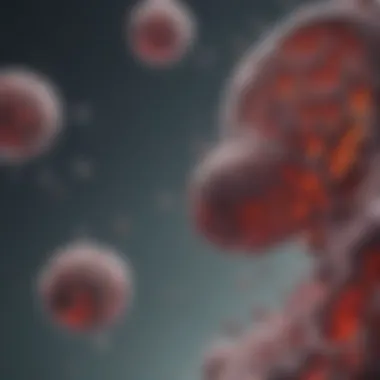Understanding the Critical Role of Liver Enzymes


Intro
Understanding the intricate roles that enzymes play in the liver is crucial for both scientific inquiry and practical health management. Enzymes, often dubbed as the body's catalysts, are fundamental in facilitating metabolic processes, aiding in the breakdown and conversion of nutrients, drugs, and toxins. Our liver, a hefty multitasker in the human body, houses a plethora of these enzymes, each designed for specific actions that support overall health and myriad bodily functions.
When discussing liver functionality, it is vital to recognize not just the types of enzymes involved but also how they interact with each other and with various substrates. This interaction is essential in regulating metabolism, detoxification, and energy production. As we delve deeper into this topic, we find that the roles of liver enzymes extend far beyond simple chemistry; they are key players in maintaining body homeostasis.
Moreover, external factors such as diet, lifestyle, and exposure to environmental toxins can influence enzyme activity and efficiency. A diet rich in antioxidants, for example, can bolster enzyme function, while excessive alcohol consumption may lead to enzyme imbalances that pave the way for liver diseases. One wouldn't be mistaken in considering liver enzyme levels as critical indicators of an individual's health status. Therefore, this article aims to shed light on the classifications of these enzymes, their physiological relevance, as well as the implications surrounding enzyme imbalance.
Throughout this narrative, we will explore diagnostic tests used to measure liver enzymes, diving into how these tests provide insight into liver health. Additionally, potential therapeutic interventions for enzyme-related disorders will be examined, rounding out a comprehensive understanding of this vital topic. Let us begin to unravel the dense fabric of liver functionality through the lens of these remarkable biological agents.
Preamble to Liver Enzymes
Liver enzymes play a pivotal role in the functionality of the liver, acting as catalysts that drive a plethora of biochemical reactions. The liver, often dubbed the body's detox center, is not just a humble organ; it is a powerhouse of metabolic activity. This introduction sheds light on how liver enzymes are central to maintaining overall health and why understanding their functionality is key for students, researchers, and health professionals alike.
In this article, we will explore the various types of liver enzymes and their significance in metabolic pathways, detoxification processes, and disease mechanisms. Enzymatic activity in the liver is not just a matter of biological interest; it has implications for diagnostics and therapeutic strategies. For example, fluctuations in enzyme levels can serve as indicators of liver health, signaling the presence of conditions such as fatty liver disease or hepatitis.
The study of liver enzymes benefits from a multidisciplinary approach, combining insights from biochemistry, medicine, and nutrition. Knowing how different factors influence enzyme activity can lead to better preventive and therapeutic measures in clinical practice.
Understanding the Liver's Role
The liver's role extends beyond mere digestion; it is deeply involved in the metabolism of nutrients, the synthesis of proteins, and the regulation of chemical levels in the blood. When we consume food, the liver ensures that nutrients are available for energy production and cellular functions. For instance, it converts excess glucose into glycogen—a stored form of energy—while also facilitating the metabolism of fats and proteins.
One might think of the liver as an intricate factory, where enzymes operate machinery that transforms raw materials into functional outputs. Each enzyme has specific substrates it acts upon, resulting in products essential for various bodily functions.
The Importance of Enzymatic Functions
Enzymatic functions are critical for several reasons:
- Metabolic Regulation: Enzymes regulate metabolic pathways that are essential for the body's energy homeostasis.
- Detoxification: Liver enzymes like cytochrome P450 play a significant role in detoxifying harmful substances, rendering them less toxic or more easily excretable by the kidneys.
- Biochemical Synthesis: Enzymes contribute to the synthesis of important biomolecules, such as cholesterol and certain hormones.
- Disease Indicators: Enzyme levels in the blood can indicate hepatic dysfunction, aiding in the diagnosis of liver diseases.
"Understanding liver enzymes is essential, as any imbalance can have cascading effects on overall health, affecting everything from energy levels to immune response."
The critical roles of liver enzymes remind us that neglecting their importance can lead to dire health consequences. Quite simply, the complexity of enzymatic functions in the liver underscores the need for continued research, educational efforts, and awareness in health care. This foundational knowledge sets the stage for the more intricate discussions of liver enzyme classification, physiological roles, and clinical significance that follow.
Classification of Liver Enzymes
Understanding the classification of liver enzymes serves as a fundamental pillar in exploring their functions and implications in health and disease. Liver enzymes are categorized based on the biochemical reactions they facilitate, each group playing its own unique role in maintaining liver functionality and overall metabolic balance. By categorizing liver enzymes, we can better understand how they interact within various metabolic pathways, how they respond to different stimuli, and their importance as biomarkers in clinical settings.
The classifications lend insight into the diverse functions of the liver, which is often dubbed the body’s "chemical factory." This classification not only helps in mapping the liver's multiple roles but also underscores the potential consequences if these enzymes become dysfunctional.
Transferases and Their Functions
Transferases are a class of enzymes that transfer functional groups from one molecule to another. In the liver, these enzymes are particularly crucial for diverse metabolic pathways. For instance, aminotransferases play an essential role in amino acid metabolism. They facilitate the transfer of amino groups, which is essential for synthesizing other amino acids or converting them into glucose through gluconeogenesis.
The functioning of transferases can be illustrated by
- Alanine aminotransferase (ALT): This enzyme is integral in converting alanine to pyruvate while simultaneously converting α-ketoglutarate to glutamate. Elevated levels of ALT in the bloodstream often indicate liver injury or damage.
- Aspartate aminotransferase (AST): While primarily involved in amino acid metabolism, AST levels also rise in response to liver damage but can also indicate muscle injury, making it less specific than ALT.
These enzymes not only showcase the liver’s role in amino acid metabolism but also highlight how their activity is an indicator of liver health.
Hydrolases in Liver Metabolism
Hydrolases are another critical class of enzymes found within the liver. These enzymes catalyze hydrolysis reactions, breaking down compounds by adding water. A prominent example of hydrolases in liver metabolism is lipases, which are crucial for breaking down fats into glycerol and free fatty acids. This process is vital for lipid metabolism.
In addition to lipases, glucosidases also come into play. They hydrolyze glycosidic bonds in carbohydrates, thereby contributing to glucose metabolism. This activity is essential in maintaining blood sugar levels, serving a vital role in how our body responds to dietary intake.
The activity of hydrolases exemplifies how liver enzymes maintain the body’s energy balance through the catabolism of macromolecules, providing substrates for other critical pathways.
Oxidoreductases: A Closer Look


Oxidoreductases are enzymes that catalyze oxidation-reduction reactions, playing a significant role in the liver's metabolic functions. These enzymes help in the detoxification process by facilitating the conversion of harmful substances into less toxic forms. One noteworthy oxidoreductase in the liver is alcohol dehydrogenase (ADH), which converts ethanol to acetaldehyde, a significant reaction in alcohol metabolism.
Another example is cytochrome P450 enzymes. They are crucial for drug metabolism, helping in the oxidation of various substances, including pharmaceuticals. Variations in the activity of these enzymes can influence drug efficacy and toxicity, underscoring their significance in both pharmacology and toxicology.
The fitness of oxidoreductases often determines how the liver manages not just nutrients, but potentially harmful substances, reflecting its protective role in overall health.
By classifying liver enzymes into these three main categories—transferases, hydrolases, and oxidoreductases—researchers and healthcare professionals can gain a clearer understanding of liver functionality, diagnose liver diseases, and develop targeted pharmacological interventions. Each group not only serves unique functions but also provides critical insight into the liver's roles in broader metabolic processes.
Physiological Roles of Liver Enzymes
The liver, often dubbed the body's chemical factory, is pivotal in maintaining metabolic balance and physiological processes. At the heart of its myriad functions lie enzymes, which act as catalysts in biochemical reactions. Understanding the physiological roles of liver enzymes illuminates their significance in health and disease, emphasizing their influence on the body's overall functionality.
Metabolism of Carbohydrates
Carbohydrates serve as a primary energy source for the body, and the liver orchestrates their metabolism through a complex series of enzymatic reactions. Enzymes such as glucokinase and gluconeogenic enzymes facilitate the conversion of glucose into glycogen for storage. This process is crucial for regulating blood sugar levels, especially during fasting or intense physical activity.
Furthermore, liver enzymes like phosphorylase play a significant role in glycogenolysis, the breakdown of glycogen back into glucose. This release of glucose into the bloodstream ensures that our energy needs are met, preventing hypoglycemia. It’s fascinating to note that a delicate balance maintained by these enzymes is essential; any dysfunction can lead to metabolic disorders like diabetes.
Protein Metabolism Pathways
The liver is a hub for protein metabolism, synthesizing various proteins that are vital for bodily functions. Transaminases and deaminases, for instance, are essential in amino acid metabolism. The intricate pathways they engage in facilitate the conversion of excess amino acids into glucose or fatty acids, thus providing energy or promoting fat storage.
Moreover, liver enzymes help synthesize plasma proteins such as albumin. Albumin is crucial for maintaining oncotic pressure in the blood, which prevents edema. When liver function is compromised, the production of albumin reduces, leading to notable physiological consequences. This aspect of protein metabolism underscores the liver's role not just in digestion but in maintaining fluid balance within the body.
Lipid Metabolism and Regulation
Lipids are another key area where liver enzymes make their mark, playing roles in both synthesis and breakdown. Enzymes such as lipase and acyl-CoA synthetase are crucial for fat digestion and energy production. They aid the liver in converting excess glucose into fatty acids, which are then stored as triglycerides.
Moreover, the liver regulates cholesterol levels through enzymes like HMG-CoA reductase, which is involved in cholesterol synthesis. Given the link between high cholesterol and cardiovascular disease, the role of these enzymes is particularly important. They not only help synthesize cholesterol but also facilitate its transport to cells, highlighting their dual role in health and disease management.
"Liver enzymes form a critical nexus through which various metabolic pathways are interlinked, enabling homeostasis and adaptation to dietary conditions."
Factors Affecting Liver Enzyme Activity
Understanding what affects liver enzymes is really crucial, as these tiny proteins are not just workhorses; they're key players in so many vital bodily functions. Enzyme activity can change, sometimes rather dramatically, based on a range of elements, which can steer bodily processes in one direction or another entirely. This section will explore how various factors can either bolster or hinder liver enzyme efficiency, impacting health and metabolism.
Dietary Influences on Enzyme Levels
Food is not just fuel; it’s a potent factor in regulating liver enzyme levels. The types of macronutrients we consume—proteins, fats, and carbohydrates—can directly affect how well enzymes function. For instance, diets high in saturated fats or refined sugars can lead to fatty liver, causing an upsurge in certain enzymes like alanine aminotransferase (ALT). On the flip side, a diet rich in antioxidants from fruits and vegetables tends to support enzyme activity favorably.
Here are a few dietary influences to consider:
- Protein Source: High-quality proteins, such as lean meats or plant-based proteins like legumes, provide the necessary amino acids that can boost enzyme production.
- Healthy Fats: Omega-3 fatty acids, found in fish and flaxseeds, have been shown to reduce inflammation, which can improve liver enzyme levels.
- Fiber Intake: Soluble fiber helps maintain a healthy gut microbiome, which is pivotal for optimal liver health and can potentially stabilize enzyme activity.
In sum, dietary habits wield a fair amount of sway over liver enzyme levels, making it paramount to pay attention to what we eat.
Impact of Environmental Toxins
Toxins are everywhere—breathe in a city, consume processed foods, even household cleaners can play a part. Environmental toxins can significantly influence liver enzyme activity, often pushing the liver to overact in an attempt to detoxify. Chemicals like pesticides, heavy metals, and solvents not only stress the liver but might lead to an uptick in specific enzyme levels as the body tries to process these harmful substances.
Some notable points regarding environmental toxins include:
- Accumulation: Chronic exposure might lead to enzyme overload, which can eventually harm liver cells.
- Inhibition: Some toxins can blunt the activity of certain enzymes, leading to metabolic dysfunctions that can affect overall health.
- Synergistic Effects: Often, it’s not just one toxin but a combination that can exacerbate enzyme instability.
Understanding the implications of these toxins reinforces the importance of safeguarding our environment to support liver health.
Role of Medications and Supplements
Medications, be they prescription or over-the-counter, can have a profound effect on liver enzymes. Some medications are metabolized by liver enzymes, which means they can either enhance or inhibit their activity. For instance, the cholesterol-lowering drug statins can lead to elevated liver enzymes in some patients, prompting monitoring or dosage adjustment.


As for supplements, they’re somewhat of a double-edged sword. Some herbal supplements, like milk thistle, are heralded for their liver-supportive properties, potentially improving enzyme function. However, others might compromise liver health.
Here’s a deeper dive into this area:
- Prescription Medications: It's essential to consult healthcare professionals about any possible liver-related side effects of prescribed medications.
- Over-the-Counter Drugs: Common pain relievers, such as acetaminophen, can increase the risk of liver damage if taken excessively or combined with alcohol.
- Herbal Supplements: While some may provide benefits, it’s a risky gamble without the stamps of approval from rigorous clinical studies.
Clinical Significance of Liver Enzymes
Liver enzymes play a pivotal role in maintaining overall health, acting as indicators of various physiological states. Their significance extends beyond mere metabolic pathways; they are crucial in diagnosing liver-related ailments, monitoring therapy effectiveness, and understanding broader health implications. Recognizing the clinical significance of these enzymes is key in both research and practical medicine.
Common Diagnostic Tests for Enzyme Levels
Several diagnostic tests are utilized to assess liver enzyme levels. These tests provide insights into liver health and can help in the identification of potential issues. Below are some of the most commonly used tests:
- Alanine aminotransferase (ALT): Primarily related to liver function, elevated ALT levels suggest liver damage.
- Aspartate aminotransferase (AST): While this enzyme is found in various tissues, higher levels indicate liver distress or damage.
- Alkaline phosphatase (ALP): Often tied to issues with bile ducts, increased ALP can reflect cholestasis (bile flow stoppage).
- Gamma-glutamyl transferase (GGT): Sensitive to bile duct problems, GGT is commonly elevated in liver disease.
- Bilirubin Test: While not an enzyme, the bilirubin level often complements enzyme tests to give a fuller picture of liver functionality.
These tests are typically performed through blood samples, and the results can reveal a great deal about liver health. A thorough understanding of these diagnostic tools helps clinicians provide tailored care for patients.
Interpreting Elevated Enzyme Levels
Elevated liver enzyme levels can signify a variety of conditions. Interpreting these levels requires careful consideration. Here are several common scenarios that might lead to increased enzyme levels:
- Hepatic cell injury: Damage to liver cells may cause ALT and AST levels to rise significantly, which could point toward hepatitis or drug-induced injury.
- Cholestasis: When bile flow is obstructed, ALP and GGT levels often see marked increases. Conditions like gallstones or primary biliary cholangitis are noteworthy here.
- Alcohol consumption: Chronic alcohol use can elevate AST, particularly when the AST/ALT ratio is greater than 2.
Elevated enzyme levels serve as a compass, guiding healthcare professionals toward the underlying causes of liver dysfunction. The context of elevation—severity, duration, and associated symptoms—is vital for a proper diagnosis.
Understanding Reduced Enzyme Activity
On the flip side, reduced liver enzyme activity can also indicate significant medical issues. This decrease may be less straightforward to interpret, but several considerations are crucial:
- Advanced liver disease: In cases of cirrhosis, the liver's ability to produce enzymes is compromised, resulting in low enzyme levels even when there is ongoing damage.
- Genetic conditions: Certain hereditary disorders may lead to insufficient enzyme production or dysfunctional enzymes, which can echo the liver's diminished capability.
- Nutritional deficiencies: Specific vitamin deficiencies, such as vitamin B6, could contribute to reduced enzyme functionality.
Understanding these nuances in enzyme activity is vital not only for diagnosis but also for crafting effective treatment approaches. By piecing together these puzzle blocks, one can gain better insight into both immediate liver health and a person's overall metabolic state.
Liver Diseases and Enzyme Dysfunction
Liver diseases and the dysfunction of enzymes are intertwined in a complex relationship, which has significant implications for overall health. The liver, often dubbed the body's biochemical factory, plays a leading role in various metabolic processes, and any disturbance in its functionality can result in cascading effects throughout the body. Understanding this interplay not only enhances our grasp of liver health but also sheds light on potential treatment strategies for various conditions.
Enzymes produced by the liver serve as key players in metabolism, detoxification, and the synthesis of important molecules. So, when liver diseases arise—such as hepatitis, fatty liver disease, or cirrhosis—these enzymes can become dysfunctional or deficient, which may lead to misdiagnosis, complications, or improper treatment approaches. By examining the repercussions of liver diseases on enzyme functions, we can highlight the necessity for precise diagnosis and appropriate interventions.
Hepatitis and Its Effects on Enzymes
Hepatitis is an inflamed liver condition that can arise from infections, autoimmune disorders, or exposure to toxic substances. One of the hallmarks of hepatitis is the elevation of liver enzymes like alanine aminotransferase (ALT) and aspartate aminotransferase (AST) in the blood. When the liver is inflamed, cells can release these enzymes into circulation, pointing to cellular damage.
"In the landscape of liver dysfunction, elevated enzyme levels stand as a sentinel, alerting both physicians and patients to underlying issues that may require immediate attention."
The elevation of these enzymes is not merely a number on a lab report; it indicates ongoing liver injury and requires careful monitoring и a thorough understanding of the underlying cause. Chronic hepatitis, often linked to viral infections such as Hepatitis B and C, can transition into liver cirrhosis or even liver cancer if not properly managed.
Fatty Liver Disease: Causes and Consequences
Fatty liver disease, or hepatic steatosis, manifests when excess fat accumulates in liver cells, which can impede normal liver function. The two main types are alcoholic fatty liver disease (ALD) and non-alcoholic fatty liver disease (NAFLD).
The consequences of fatty liver extend beyond mere enzyme dysfunction; they encompass a spectrum of liver conditions that can evolve over time. Moreover, elevated liver enzymes may indicate heightened liver stress or inflammation due to the excessive fat deposits. With NAFLD surging in prevalence globally, understanding the causes, such as metabolic syndrome, obesity, and poor diet, becomes crucial in mitigating its impact.
- Diet: High sugar intake and unhealthy fats contribute to fat buildup.
- Genetics: Family history plays a role in susceptibility.
- Sedentary lifestyle: Lack of physical activity exacerbates symptoms.
Cirrhosis and Enzyme Disruption
Cirrhosis, a late-stage liver disease, entangles various underlying causes, including chronic alcohol abuse, hepatitis, and metabolic disorders. As liver cells are replaced by scar tissue, enzyme production diminishes, resulting in a cascade of dysfunctions. The scare tissue disrupts normal blood flow through the liver, contributing to increased pressure in the portal vein and the resultant complications like esophageal varices.


This progressive burden on the liver impairs the organ's ability to filter toxins, regulate hormones, and metabolize nutrients. Notably, decreased enzyme levels can lead to a slowdown in the detoxification processes, fostering an environment where hepatotoxic (liver damaging) substances can thrive.
Equipped with this understanding, it's essential to monitor liver functions closely, especially in patients with chronic liver diseases. Emerging therapeutic options and lifestyle changes are critical factors in ameliorating liver enzyme imbalances and restoring functionality.
Therapeutic Approaches for Enzyme Imbalance
Exploring therapeutic approaches for enzyme imbalance is crucial since enzyme levels are indicators of liver health. When their levels stray from the norm, it signals that something’s not quite right in the body's metabolic processes. These imbalances can stem from various factors, including lifestyle choices, diet, environmental toxins, and certain diseases. Effective management of these imbalances not only restores enzyme levels but also supports overall liver functionality. Thus, a multi-faceted approach is essential.
Nutritional Interventions and Their Impact
Nutrition plays a pivotal role in maintaining healthy enzyme activity. A well-rounded diet influences the liver’s ability to synthesize and regulate enzyme levels. Consuming nutrient-dense foods can provide the necessary vitamins and minerals that support liver functions. For example, amino acids from lean proteins aid in enzyme synthesis, while antioxidants from fruits and vegetables help combat oxidative stress on the liver.
Some specific foods include:
- Leafy greens: Spinach and kale promote detoxification.
- Cruciferous vegetables: Broccoli and Brussels sprouts can enhance enzyme production.
- Nuts and seeds: Rich in healthy fats, they support overall liver health.
- Fatty fish: Salmon and mackerel offer omega-3 fatty acids, which have anti-inflammatory properties.
Hydration is equally important; drinking sufficient water helps in digestion and aids in the transport of enzymes. A poor diet high in sugars and unhealthy fats can lead to fatty liver disease, resulting in enzyme dysfunction. Therefore, making conscious dietary choices is fundamental in balancing liver enzyme levels.
Pharmacological Treatment Options
When nutritional adjustments aren’t sufficient, pharmacological interventions may be necessary. Depending on the specific enzyme imbalance and underlying condition, doctors might prescribe various medications. For instance, if elevated liver enzymes indicate hepatitis, antiviral drugs like Sofosbuvir or Ledipasvir could be introduced to manage inflammation and restore normal enzyme levels.
Another pathway involves using supplements that aim to enhance liver health. Compounds such as milk thistle, which contains silymarin, are often touted for their liver-protective abilities. However, it’s vital to approach these options cautiously, as not all supplements are regulated and can interact negatively with other medications.
"Understanding the root cause of an enzyme imbalance is fundamental before opting for any pharmacological approach."
Lifestyle Alterations for Improved Health
Lastly, shifting lifestyle habits can create significant improvements. Regular physical activity, such as aerobic exercises and resistance training, can enhance metabolic processes and, in turn, support enzyme function. Even moderate activities like walking can make a difference. Additionally, maintaining a healthy weight helps in preventing conditions like non-alcoholic fatty liver disease, which severely affects enzyme levels.
Other lifestyle factors include:
- Minimizing alcohol consumption: Excessive drinking can lead to liver damage and higher enzyme levels.
- Avoiding excessive use of over-the-counter pain relievers: Such as Acetaminophen, can stress the liver.
- Stress management techniques: Practices like yoga and meditation can improve overall well-being and support liver health.
Research Frontiers in Liver Enzyme Studies
In the domain of liver functionality, exploring the latest research frontiers on liver enzymes holds pivotal significance. The investigations into these enzymes not only enhance understanding of their biological roles but also unravel their connection to various health issues. As researchers big and small congregate their findings, it seems that the role of enzymes is far more intricate than previously thought. These enzymatic activities can give insights into liver health, signaling toward potential therapeutic approaches.
The field is evolving, with focused studies shedding light on specific attributes of liver enzymes:
- Precision Medicine: The shift towards personalized medical treatments has made genetic variations in enzyme activity a vital area of inquiry. Understanding individual differences allows for tailored interventions, increasing efficacy while minimizing adverse effects.
- Biomarker Development: The ongoing refinement of liver enzyme analysis is paving the way for discovering new biomarkers. These indicators can reveal intricate details about liver damage, disease progression, and treatment outcomes.
- Pathophysiological Insights: Carving out a clearer picture of how enzyme dysfunction correlates with various liver diseases helps to unravel complex disease mechanisms. These insights are essential for formulating effective therapeutic strategies.
Research in this field is ripe with opportunity, promising not only to deepen comprehension but also to lead to groundbreaking innovations in treatment. The implications are substantial, with benefits potentially extending to the realms of drug metabolism and toxicity assessment.
Emerging Techniques in Enzyme Analysis
As new tools and methodologies become available, they vastly improve the accuracy and sensitivity of liver enzyme detection. Techniques like mass spectrometry and high-performance liquid chromatography have revolutionized how scientists analyze enzymatic activity. Through these advanced techniques, researchers can achieve:
- Higher Sensitivity: Detecting lower concentrations of enzymes means identifying liver damage earlier. Timeliness can be a game-changer in treatment outcomes.
- Dynamic Range: These methods ensure that even small fluctuations in enzyme levels can be accurately monitored, allowing for more precise clinical evaluations.
- Complex Assays: Overlaying various testing methodologies can yield a multi-faceted view of liver enzyme dynamics, incorporating multiple factors influencing liver health.
The Relationship Between Genetics and Enzyme Function
With the spotlight on genomics, the intersections between genetics and liver enzyme function are receiving much-needed attention. Studies are highlighting how genetic predispositions can determine enzyme activity levels and efficiency. Certain alleles, for instance, can lead to variations in enzyme production or activity, influencing susceptibility to liver ailments. Such findings emphasize:
- Genetic Screening: Identifying individuals at risk of developing liver dysfunction could lead to early interventions, potentially preventing disease onset.
- Individualized Treatments: Tailoring medical treatments based on genetic makeup could enhance therapeutic effectiveness and minimize side effects.
Future Directions in Therapeutic Research
Looking ahead, the landscape of therapeutic research concerning liver enzymes appears vibrant. The ongoing investigations are not just attempting to rectify enzyme imbalances but to innovate novel attempts in managing liver diseases. Potential avenues include:
- Developing Enzyme Modulators: Creating specific agents to either amplify or inhibit enzymatic activity could provide targeted therapeutic options.
- Regenerative Medicine: Stem cell therapies aimed at restoring enzyme production may emerge as a radical approach in treating liver diseases.
- Nutraceutical Innovations: There seems to be an evolving recognition of diet-derived compounds that could modulate liver enzyme activities favorably.
Emerging research in liver enzymes underscores a paradigm shift, compelling us to reconsider existing therapeutic frameworks while offering a hopeful glimpse into future medical advancements.
"The unfolding narrative of liver enzymes in health and disease encapsulates a journey of discovery. The interplay of exploration, genetics, and technology invariably shapes our understandings and potential remedies, paving the way for healthier futures."
By further delving into these frontiers, the expansive role of enzymes continues to provide a lens through which human health is better understood and optimized.







